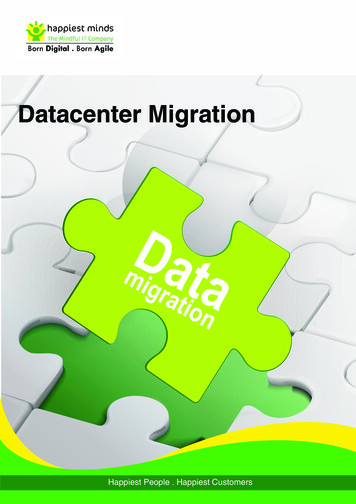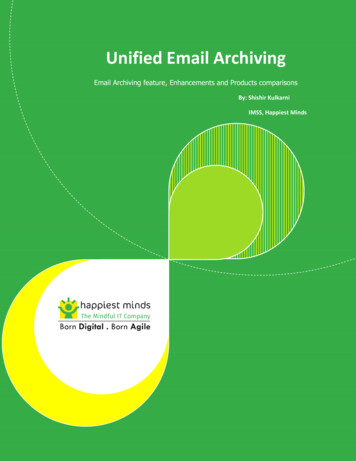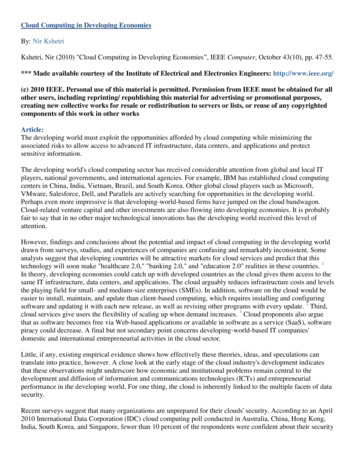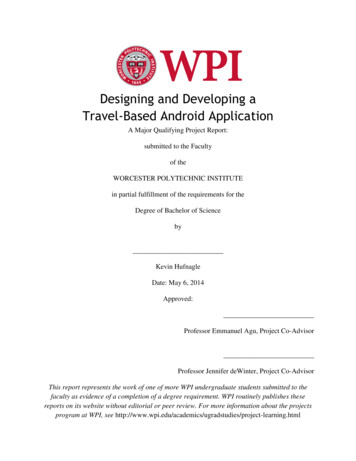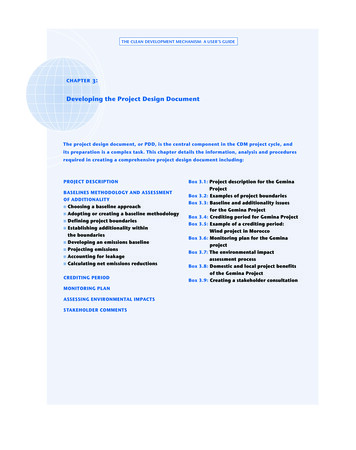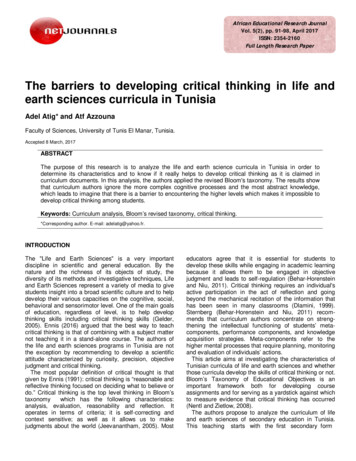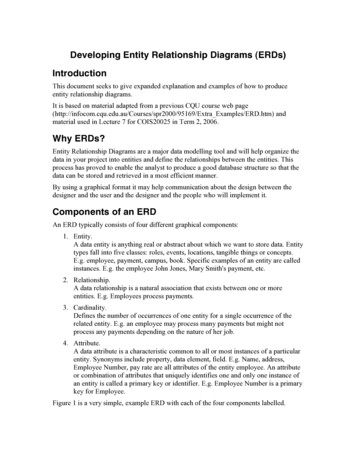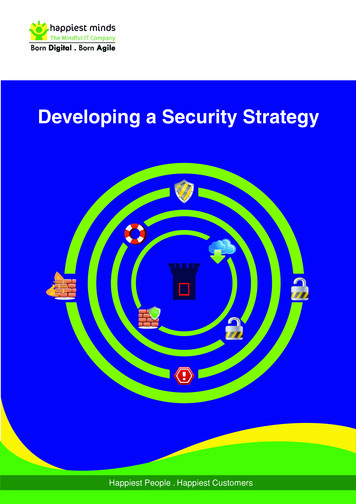
Transcription
Developing a Security StrategyHappiest People . Happiest Customers
ContentsIntroduction. 3Strategy, planning and development. 3Development process. 3Organization, People, Process And Technology. 4Assumptions, constraints and resources. 5Gap analysis and risk assessment. 6Plan. 6Assess & Analyze:. 6Report. 6After completion of above activities, the next steps are as follows. 6Management responsibility and expectations. 7Each strategic objective will need adhere to the following tenants, goals, and objectives. 7Conclusion. 7About the Author. 82 Happiest Minds Technologies. All Rights Reserved
IntroductionWhat is a security strategy?Business organizations develop and maintain strategic plans for most of the activities they carry out. Strategic plans definethe need for an action, the impact of that particular action and driving forces behind the action. Security strategy in any organization starts with an in-depth analysis of their business. A security strategy is thus an important document which details outseries of steps necessary for an organization to identify, remediate and manage risks while staying complaint. Aneffective security strategy is comprehensive and dynamic, with the elasticity to respond to any type of security threat.Developing a security strategy is a detailed process that involves initial assessment, planning, implementation andconstant monitoring. It may also include a combination of actions that counter imaginable threats and vulnerabilities: policiesand procedures, access management measures, communications systems, technologies and systems integration practices.The security strategy document defines and prioritizes information assurance and security initiatives that the organizationmust commence to enhance the protection of information and related technology. Ideally an organization should consolidatepreviously identified and executed projects (where practical), provide scope and definition for each of the identified efforts,detail the general risks addressed by the initiative and provide a foundation that can later be refined by senior management.Additionally, to support higher-level evaluation of initiatives that can be undertaken when required, the security strategy planning process needs to identify any significant dependencies associated with the initiativeStrategy, planning and developmentLeadership and management commitmentTo protect an organization effectively through a well-planned security strategy, I.T, the important mission enabler, needsrecognition as an important component of the organization. Effective and efficient information security programs requireco –operation from business leaders and personnel within the organization along with clear direction and commitment fromtop management and administration. Information Assurance and Cyber Security are integrated functions that require effective collaboration throughout the organization. It is imperative for security strategists to have everyone required on board, sothat they know the value of the assets being protected and the real cost of breaches which can then help determine currentand future security requirements.3 Happiest Minds Technologies. All Rights Reserved
Development processThe process of security strategy development can be depicted as sDeterminecurrent stateand definedesired statePerform Gapanalysiswith riskassessmentmanagementplansDesignMonitoring andmetrics forcontrolsDesigncontrolswith availableresourcesDetermineresources anddefineconstraintsSet controlobjectives andevaluate ControlchoicesOrganization, People, Process And TechnologyThe most important part of developing a security strategy is understanding the key elements of the specific businesshouse. While it is essential to understand generic threats and vulnerabilities, the ones which can impact a particularorganization is vital. Security strategists need to decide on how much effort, time and money is required to developorganization specific security policies and controls.Industry guidelines such as COBIT may be used to plan and decide on the framework for aligning IT governance objectives,process definitions, high-level requirements for control management for each of those processes and management guidelines to help arrive at maturity levels.A proper understanding of the organization’s environment where business and IT goals are aligned, taking account of factorssuch as applications, databases, networks, information exchange and workflows in information management system, reporting, research and records management needs to be undertaken. The roles and responsibilities required for various positionswithin I.T and business needs to be documented. Identification of personnel with relevant skillsets, requirements for trainingto enhance or develop functional and technical competencies needs to be commenced. Awareness around concepts ofintegrity, confidentiality, and privacy is an essential component for any security strategy. Consistent efforts must be carried4 Happiest Minds Technologies. All Rights Reserved
out to ensure that the workforce is adequately trained on these concepts and that people are fully aware of their role andresponsibility in the organization lifecycle.A detailed understanding of the various I.T processes such as demand, capacity, investment, human resources,quality, education and training, internal control, compliance, performance, operations, service, vendor, portfolio and SDLCetc., are required. Processes should be assessed for maturity prior to the security strategy planning and areas which requireimprovement must be identified. An action plan should be drafted ensuring the gaps are bridged through implementation ofspecific controls (logical and technical). Detailed understanding of how the information flows through the ecosystem, thetype of data classification (if it exists) and characterization of such data, interoperability and information exchange isrequired to gain insight into the data management process.Certain key requirements, such as, legal, regulatory, statutory, business and contractual needs to be identified and compared against internal processes, policies and procedures. Raising awareness through training campaigns and periodicassessments are extremely important.External parties play a vital role in any organization. They can be internet service providers, attorneys, IT services such asapplication development, testing, maintenance, hardware support, managed services, device vendors etc.Acomprehen-sive security strategy should include steps on how the external party must be assessed for security andcompliance. The scope needs to include I.T, people and facilities in addition to how data is being collected, processed,stored and disposed within the organization. Documents that include the organization’s policies, procedures, contract oragreement and reporting to service levels should be examined as well.Assumptions, constraints and resourcesWhile developing a security strategy, certain assumptions needs to be factored in. They can be planned projects by I.T andbusiness teams, processes that are undergoing re-engineering or improvements, discussions on how personnel andbudgets will be managed more effectively, the various groups or committees that will be formed for audit, security and riskmanagement etc.Constraints are limitations or restrictions or conditions that may prevent or diminish the achievement or implementation ofa component or the entire strategic objective. Constraints can be contextual, be it legal, physical, ethical, policies, culture,costs, personnel, organizational structure, resources, capabilities, time and risk tolerance or operational - manageable,maintainable, efficient, effective, proportional, reliable, accurate and in-scope. These can also be the magnitude of effort,resources required for development, implementation, testing and support, challenges around legacy systems, integrationwith existing technologies, processes, changing or upcoming legislation and customer requirements. All applicableconstraints must be identified during strategic planning process and taken into consideration for each objective.Resources can be defined as any activity, process, asset, technology, individual, policies, procedures, standards, guidelines, architecture, controls, technology, personnel, roles and responsibilities, awareness etc; that can be utilized in somemanner to move toward addressing a gap and thus serves in implementing the security strategy. Even if an organization iscovered with firewalls one weak link in the chain can usher an attacker. Thus, the selection of appropriate security controlsis an extremely important task having major implications on the operations and assets of any organization. Out of allresources, humans are mostly considered the weakest link and thus training and awareness should be an ongoing part ofa comprehensive security strategy.Information security is everybody’s responsibility and not just the IT department. Many users within an organization limitthemselves to following just the basic compliance. A successful security strategy must include every stakeholder within itsfold and develop consistent processes and strategies motivating users to take ownership and help build a soundsecurity policy.45 Happiest Minds Technologies. All Rights Reserved
Gap analysis and risk assessmentIn order to determine the current state of information security governance attributes and characteristic, approaches fromindustry guidance such as COBIT, ISO-27001/2, CMM or other can be utilized. A detailed gap analysis or assessment isone of the essential steps in understanding the bridge between current and desired state. The following processes aregenerally followed:Plan: Setting the context Understanding business goals, objectives, critical risk and success factors Identifying legal, statutory, regulatory and contractual applicability Defining the scope and boundaries for the exercise Preparing a project plan that includes schedule or timelines, information regarding stakeholders – internal, vendorsor contractors, business units, processes, list of documents that must be reviewed, resources required and deliverablesexpected. Identifying assets – application, database, confidential and sensitive data, infrastructure devices, facility, people etc. Identifying threats and determine risk criteria based on current framework or industry best practices Preparing assessment questionnaireAssess & Analyze: IT governance framework, risk management practices, business processes, I.T processes and organizational structureReview documentations such as policies, procedures, handbooks, manuals, previous audit or assessment reports, currentsecurity practices, I.T architecture and perform applications walkthrough Interview stakeholders based on assessment questionnaire, understand security awareness and adherence torequirements and controls Perform control assessment on identified scope Determine impact and likelihood of threats – source, nature, current controls, asset and data criticality,data sensitivity etc. Estimate identified risks and perform risk evaluation to compare against implemented controls, significance andmitigating factorsReport: Map current processes to controls Determine desired state Identify remediation activities, assign priorities and develop remediation plan Prepare draft report and review that with stakeholders Incorporate feedback and develop final gap analysis and risk assessment reportAfter completion of above activities, the next steps are as follows: The control objectives are tasks that address the risks identified during the previous stage and helps bring the currentstate to the desired state. Control objectives can be determined by examining the gap analysis and risk assessmentreport and aligning them with industry guidelines such as COBIT, ISO-27001/2 etc. Risk treatment options needs to beevaluated and a treatment or remediation plan developed to ascertain what risks need to be mitigated and to whatextent. The residual risks, risk acceptance criteria along with legal, statutory, regulatory and contractual requirementsand current controls implemented needs to be included while selecting control objectives. The next step would be to compile a list of controls that can be evaluated against available resources. Both contextualand operational constraints need to be determined and evaluated against these control choices and modified orreplaced accordingly. In order to achieve the required assurance level, the control strength needs to be examined todetermine the reliability and effectiveness and then a decision should be taken whether additional protection mechanisms are applicable and or required.46 Happiest Minds Technologies. All Rights Reserved
For each control choice, the applicable metrics and monitoring mechanism needs to be designed. Indicator conceptscan be used for measurement of performance and effectiveness of goal accomplishment. These indicators enable theevaluation of process in alignment with business strategy. A security dashboard is essential and is primarily composedof dissemination of knowledge, measurement of processes and their maturity level, performance of critical processes,information for stakeholders, conformance level, surveillance of processes gap and alarming functionalities etc.Management responsibility and expectations: The Chief Information Security Officer (CISO) should ideally be the strategic administrator and ultimately responsiblefor the creation, administration and communication of this security strategic plan. The CISO may assign otherpersonnel as required to manage specific tactics or to facilitate strategic planning activities. The CISO may assign a manager from each business unit to look at a specific objective, as and when required. Theassigned manager shall report progress on that tactic on, at minimum, a monthly basis, or more frequently dependingon the requirement. . The strategic administrator needs to review, consolidate and communicate the progress of the strategic plan topersonnel and business units on a quarterly basis at minimumEach strategic objective will need adhere to the following tenants, goals, and objectives: Acquisition and implementation of common enterprise security tools to maximize cost reductions with economies ofscale. Technologies, tools and solutions must be integrated to the maximum possible capacity providing automatedenterprise-wide visibility into the security structure of the organization’s information and information systems. Standardization decisions will need to be formally documented and the resulting standard or specific product in caseswhere there are no standards-based solutions available will need to be incorporated into the enterprise architecturetechnical reference model. Consideration should be given to leveraging and integrating existing investments to the greatest extent possible toconserve available constrained budgetary resources. Solutions should not be conceived in a fashion where consideration is given towards addressing only a single risk orrequirement. Solutions should collectively be able to mitigate risks while addressing cost efficiency. .ConclusionStrategy implementation, testing and reviews are other activities should be planned as part of the development. Ideally,the executive committee and the Board needs to review the security strategy with the CISO, understand the implicationsand effects provide feedback on each initiative strategic objective and allow time for the CISO to respond to the commentsand send the next version to the strategic committee for discussion, refinement and approval. The CIO and CEO shouldreview, approve and communicate the final security strategy document to the intended audience. The CISO shall thenofficially publish the same to all relevant stakeholders. To measure success of the security strategy, one must ensure thatinitiatives provide enough flexibility to adjust to abrupt changes in business, legal and technical environments. Thestrategic task must generate a sense of eagerness among the personnel so that they follow the plan and take personalownership ensuring its success. Managers and personnel need to be held accountable for the success or failure of theirassigned initiatives and tactics. A security strategy is not a one-time activity and thus assessments must be done at leastquarterly to measure effectiveness of implemented initiatives. It should be revised periodically reflecting changes inlegislation, business and technology47 Happiest Minds Technologies. All Rights Reserved
About the AuthorAshok Kumar DL is a seasoned InfoSec Consultant with rich experience in consulting, designing, implementing, assessing and managing large and complex InfoSec projects across industry verticals. Hebrings in over 13 years of experience in Governance, Risk, Compliance, Business Continuity, Identity &Access Management, Disaster Recovery, Privacy, Threat and Vulnerability Management.Ashok Kumar DLHappiest MindsHappiest Minds, the Mindful IT Company, applies agile methodologies to enable digital transformation for enterprises andtechnology providers by delivering seamless customer experience, business efficiency and actionable insights. We leverage aspectrum of disruptive technologies such as: Big Data Analytics, AI & Cognitive Computing, Internet of Things, Cloud, Security, SDNNFV, RPA, Blockchain, etc. Positioned as “Born Digital . Born Agile”, our capabilities spans across product engineering, digital businesssolutions, infrastructure management and security services. We deliver these services across industry sectors such as retail, consumerpackaged goods, edutech, e-commerce, banking, insurance, hi-tech, engineering R&D, manufacturing, automotive and travel/transportation/hospitality.Headquartered in Bangalore, India; Happiest Minds has operations in USA, UK, The Netherlands, Australia and Middle East.Business Contact: business@happiestminds.comMedia Contact: media@happiestminds.com Happiest Minds. All Rights Reserved.E-mail: business@happiestminds.comVisit us: www.happiestminds.comFollow us onThis Document is an exclusive property of Happiest Minds Technologies812 Happiest Minds Technologies. All Rights Reserved9
effective security strategy is comprehensive and dynamic, with the elasticity to respond to any type of security threat. Developing a security strategy is a detailed process that involves initial asse

